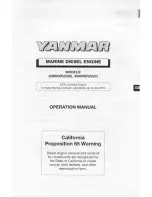
03.2.3 Automatic stop
When the shut-down solenoid is energized from the automatic
shut-down system due to some disturbance, the engine will stop
as in remote stop. Before this an alarm device will normally
initiate an alarm signal indicating the reason for the shut-down.
When the engine stops because of overspeed, the mechanical
overspeed trip device and the electro-pneumatic overspeed trip
device may have tripped.
03.2.4 General
The engine can always be stopped manually (with the stop lever)
independent of the remote control or automation system.
Caution!
When overhauling the engine, make absolutely sure that the
automatic start and the priming pump are disconnected.
Close the starting air shut-off valve located before the solenoid
valve. Move the stop lever into STOP position.
If the engine is to be stopped for a lengthy time, close the
indicator valves. It is also advisable to cover the exhaust pipe
opening.
The lubricating oil system on a stopped engine should be filled
with oil every second day by priming the engine. At the same time,
turn the crankshaft into a new position. This reduces the risk of
corrosion on journals and bearings when the engine is exposed
to vibrations.
Blow the engine with open indicator valves and start the engine
once a week to check that everything is in order.
03.3
Normal operation supervision
03.3.1 Every second day or after every 50 running
hours
1 Read all thermometers
and pressure gauges and the load
of the engine. Compare the values read, with those at corre-
sponding load and speed in the Acceptance Test Records and
curves. Guidance values are stated in chapter 01.
•
if the difference between exhaust gas temperatures of vari-
ous cylinders is larger than 80°C at loads higher than 25 %
the reason for this should be looked for,
•
the charge air temperature should, in principle, be as low as
possible at loads higher than 60 %, however, not so low that
condensation occurs, see Fig 03-1. At loads lower than 40 %
03
Start, Stop and Operation
22-9632
03 - 4
VASA 22
Summary of Contents for Vasa R22
Page 14: ...Appendix B Welding Precautions 200147 00 4...
Page 42: ...02 Fuel Lubricating Oil Cooling Water 22 9601 02 22 VASA 22...
Page 60: ...03 Start Stop and Operation 22 9632 03 12 VASA 22...
Page 72: ...04 Maintenance Schedule 22 9845 III 04 12 MD HF...
Page 92: ...06 II Adjustments Clearances and Wear limits 22 9601 06 6 VASA 22...
Page 116: ...08 Operating Troubles Emergency Operation 22 9601 08 8 VASA 22...
Page 144: ...11 Crank Mechanism 22 9601 11 18 VASA 22...
Page 156: ...12 Cylinder Head with Valves 22 9601 12 12 VASA 22...
Page 164: ...13 Camshaft Driving Gear 22 9601 13 8 VASA 22...
Page 172: ...14 Valve Mechanism and Camshaft 22 9601 14 8 VASA 22...
Page 183: ...22 200520 Turbocharging and Air Cooling 15 VTR Turbocharger 15 11...
Page 189: ...15 III Turbocharging and Air Cooling 22 8604 15 6 VTR 161 251 Turbochargers...
Page 209: ...17 Fuel system 22 9601 17 8 VASA 22...
Page 229: ...18 Lubricating Oil System 22 9601 18 20 VASA 22...
Page 247: ...19 Cooling Water System 22 9601 19 18 VASA 22...
Page 261: ...21 Starting Air System 22 9601 21 10 VASA 22...
















































